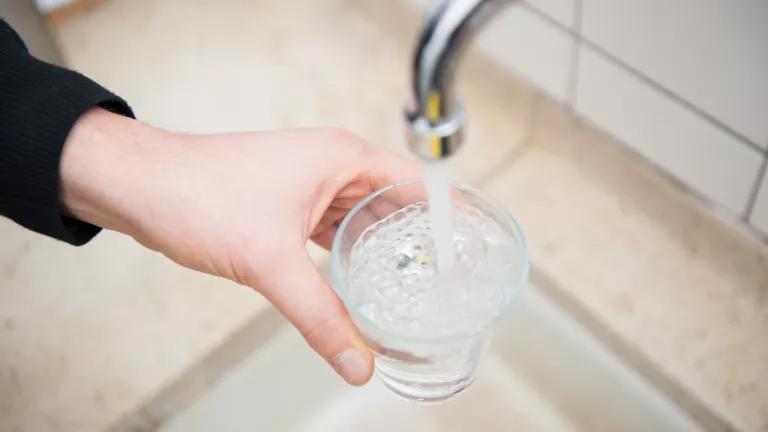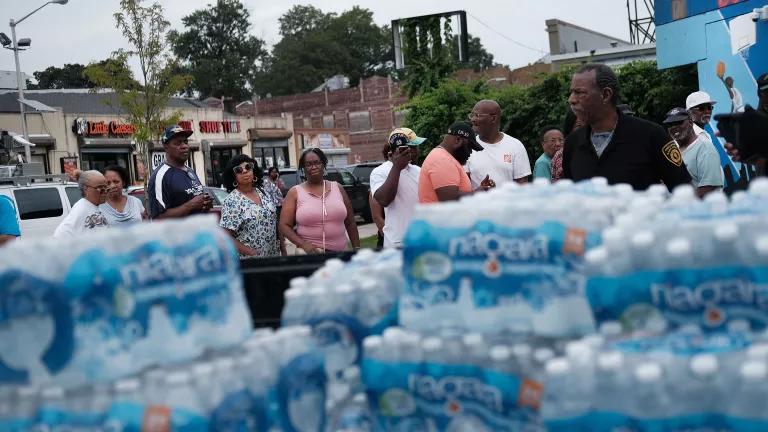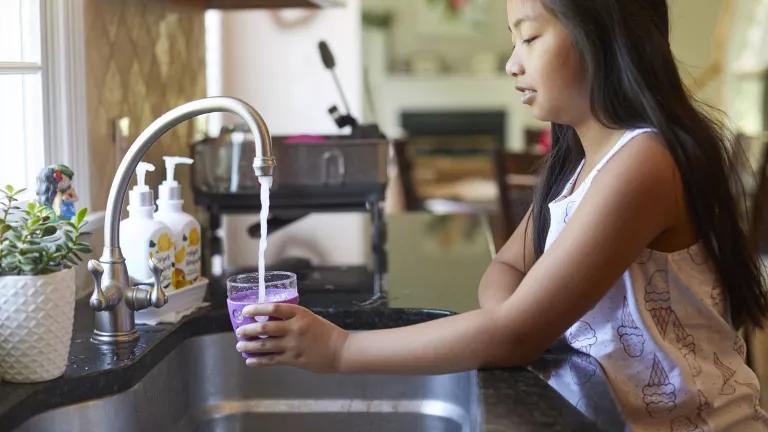Bipartisan Infrastructure Law Means Big Investments in Safe Water and Lead Pipe Removal
The new Bipartisan Infrastructure Law means safer drinking water could be in your family's future, with a $30 billion investment in cleaning up lead, toxic "forever chemicals" known as PFAS, and other contaminants from our tap water.
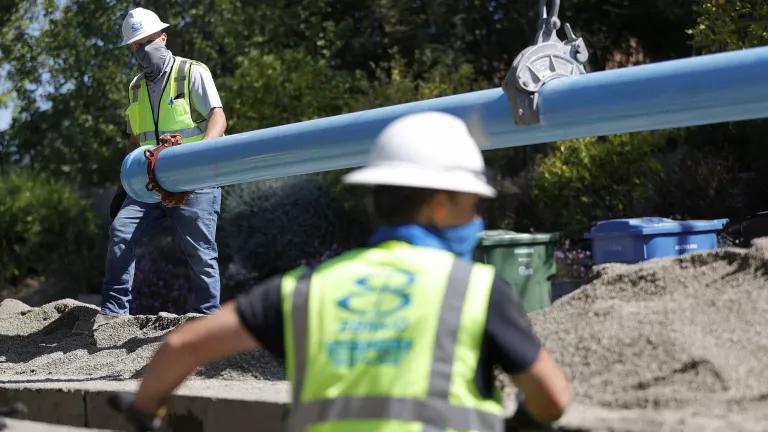
Workers with East Bay Municipal Utility District (EBMUD) install a new water pipe in Walnut Creek, California on April 22, 2021.
With all the bad news about Ukraine and other crises greeting us at every turn, there is some good news to share that’s important to millions of Americans. The “Bipartisan Infrastructure Law” (the BIL) that was enacted just before Thanksgiving time last year—formally called the Infrastructure Investment and Jobs Act—will invest about $30 billion to address some of the urgent backlog in necessary repairs and upgrades for the nation’s drinking water systems. I am testifying about this important law in the House of Representatives’ Energy & Commerce Committee’s Environment & Climate Change subcommittee at a hearing on March 29.
As a result of the BIL drinking water system upgrades will be funded in communities across the country. Lead pipes called “lead service lines” that connect homes to the water main in the street will be pulled out of the ground and replaced. These investments will protect our families’ health and create good living-wage jobs for tens of thousands of Americans.
Decades of neglect and divestment have resulted in an enormous buildup of badly needed repairs for our drinking water systems. Congress and the Biden administration demonstrated the courage and will to make this truly significant and historic investment in infrastructure that will pay dividends well into the future. We must ensure that these funds, especially grants, are prioritized to help the disadvantaged communities that need it most.
The BIL will invest $15 billion to help remove lead service lines across the country. These lead pipes threaten the health of tens of millions of Americans, especially children and low-income communities. The BIL’s investment will take a significant bite out of this problem; additional funding including the $10 billion for removing lead from drinking water included in the House-passed reconciliation bill (H.R. 5376) is needed.
The BIL also invests $9 billion to address emerging contaminants in drinking water, principally to help address the PFAS contamination crisis. Another $11.7 billion is invested via the Drinking Water State Revolving Fund for drinking water priorities.
Infrastructure investment creates good jobs. For example, a 2021 study by E2 (Environmental Entrepreneurs) and United Association of Journeymen and Apprentices of the Plumbing and Pipefitting Industry (UA) found that investing in replacing our lead service lines alone would create 560,800 job years, providing good-paying jobs for American workers. Newark New Jersey has shown how this can be done, replacing 23,000 lead service lines citywide in less than three years by hiring local residents at a living wage who were trained by a local union.
Safe drinking water, which we all take for granted in the United States cannot be considered a given. Much of our nation’s water infrastructure is like a rusty decades-old car that hasn’t been maintained or had an oil change or brake job for years. It may still be barely running, but we need to make major investments to upgrade and fix it, or it will gradually die and may even catastrophically fail.
The $30 billion BIL allocations are historic, though according to industry estimates $1 trillion will be needed to fully address drinking water infrastructure needs. The profound level of disrepair means that more investment, like what is included in the House reconciliation bill, is needed.
Despite our successes and efforts to date, drinking water contamination still wreaks devastating impacts. Our 2021 NRDC study found that there are 9 to 12 million lead service lines, lead contamination of school drinking water is widespread, and tens of millions, perhaps more than 100 million Americans, are drinking PFAS in the tap water.
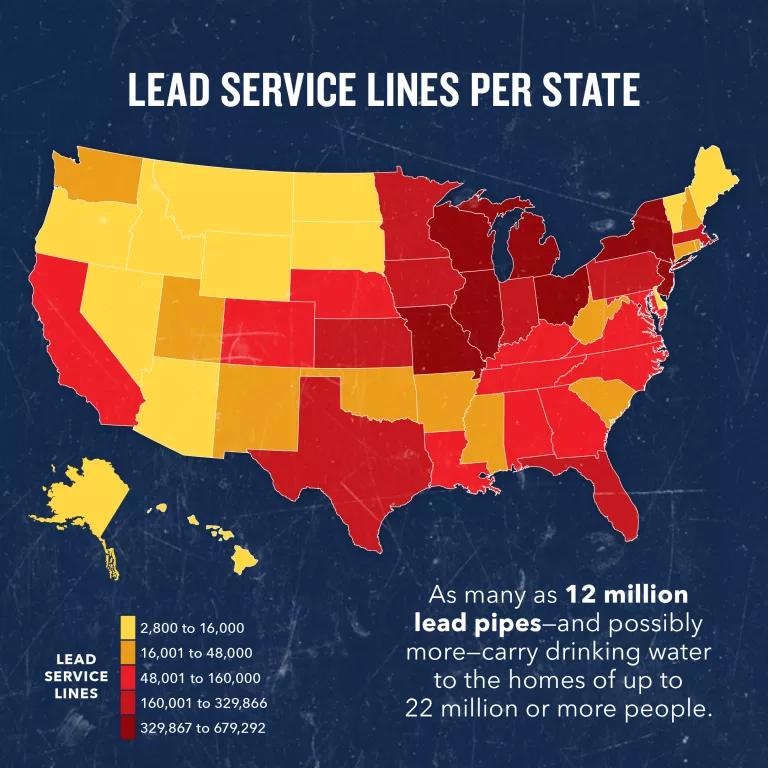
CDC estimates that 7.1 to as many as 12 million Americans are sickened annually by pathogen-contaminated tap and other water. That doesn’t include the impacts of toxics. And NRDC published a report analyzing EPA’s data and found that tens of millions are served by water systems violating EPA’s health standards.
There are three underlying causes of these ongoing problems: (1) underinvestment in our water infrastructure, so water systems too often rely on outdated and inadequate treatment and distribution systems; (2) a broken Safe Drinking Water Act that leaves in unregulated, widespread, and hazardous contaminants like PFAS and allows weak enforcement of the drinking water standards that do exist; and (3) poor to nonexistent controls on many major water polluters. Low-income areas often lack access to safe drinking water, and for 2 million people—for example on some Indigenous lands, in the colonias along the U.S. border, in the rural South, and in pockets of Appalachia—they have no running water or sanitation at all.
Part of the solution is for us to make sure we aren’t contaminating our water before we use it. Protecting water sources helps to safeguard health and reduces treatment costs. We should be doing everything we can to reduce water pollution in the first place, so we don’t need to clean it out of our tap water at our drinking water treatment plants. Additionally, we need to make sure we’re prepared for the future threats to our water supplies that are coming due to climate change. As I mentioned in an earlier blog, last year’s disaster in Texas, with widespread water and power outages due to an extreme storm, should teach us that we are unprepared for what we know is in our future. There are increasing challenges to water infrastructure from extreme weather and droughts that are posing real risks.
We envision a day when every person in this great nation—whether a resident of a major city, a small rural town, a tribal community, or an underserved impoverished isolated community—will drink safe and affordable tap water. The BIL takes a major historic step forward to help us move toward this goal, but more will be needed.
Our recommendations:
- Implement the BIL by investing first in those communities that need it most.
- Invest additional resources in fixing our water infrastructure, paying special attention to the affordability and needs of lower-income and disproportionately affected communities.
- Fix lead in our water, including removing all lead service lines, fixing the Lead and Copper Rule, and addressing lead in schools and childcare centers.
- Fix the broken Safe Drinking Water Act to ensure controls on key contaminants like PFAS.
- Protect source water to reduce infrastructure costs and health and environmental harms.
- Protect water infrastructure from extreme weather events and possible terrorist attacks.
- Invest in technologies, including broad-spectrum treatment and real-time and other advanced monitoring.
- Let citizens act immediately to address imminent and substantial health endangerment.
- Vigorously enforce the Safe Drinking Water Act.

